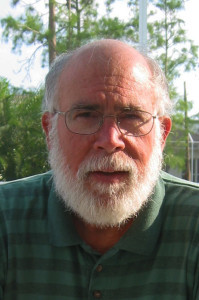Riley Adams's Blog, page 116
July 30, 2015
A Changing Marketing Mindset
By Elizabeth S. Craig, @elizabethscraig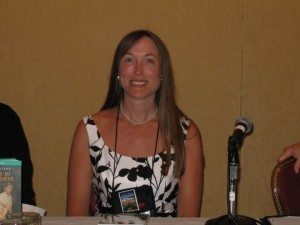
My firstborn will be leaving home for college in a couple of weeks and it’s put me in a reflective mood. This is unusual for me, since I’m ordinarily not even reflective at the end of the year.
My first traditionally-published book was Pretty is as Pretty Dies in 2009. At the time, Kindle wasn’t even really making a ripple in my consciousness. I had an author friend of mine at a signing to tell me that he had a Sony ereader and it seemed sort of Star Trekkish to me. I couldn’t imagine wanting to read on one or what the potential benefits might be.
I’d thought the same thing about personal computers when I became introduced to them in the 80s. The contraption looked like an unwieldy typewriter to me and I couldn’t conceive how it could be useful to me. Then the internet came into play and suddenly computers were life-changing for me in every way…ingraining themselves into my routines and habits.
Before my first book came out, I had an actual teleconference with the publisher, my editor, a book designer, and in-house marketing people on cover design and a marketing strategy! This was 2009 for Midnight Ink. This never happened again for me, with any other imprint or publisher.
My feelings toward marketing went through several different iterations. There was the moment when I realized the burden of promo was actually on me, not the publisher. I obediently jumped into action…sort of. I did the suggested blogging and social media, even signing up for a course on how to get started. But I retained a sense of shyness around readers and decided to stay within my comfort zone of sharing resources and interacting with writers. I remember in early 2010 I was at a conference and a fellow author said, “Penguin has got to love you. You’ve got so many followers on Twitter!” And I said, “I don’t think they have the slightest idea that I’m even on social media.”
By the time my imprint, Obsidian/NAL had a presence on Twitter, I was about 20,000 followers ahead of them. And then they were very aware of social media and its use in promo. I was asked to retweet them or plug my book. This made me uncomfortable because it wasn’t my M.O. on Twitter. I don’t promote there. I reluctantly sent a couple out, but the whole time I was thinking…why are they even on Twitter? For the most part, that’s not where their readers are found. They’re on Pinterest and Facebook. Even I knew that, and I’m not even big on either platform. The reason I’m on Twitter is because that’s where writers and industry people are.
So there started to be, for me, a little tension there. Not ever between my editor and me—she was always fantastic. But between me and the publisher. I felt a lack of support in the marketing arena and then a sort of resentment that I’d had to learn every darned thing myself…the blogging, copy writing, social media, finding authors to blurb me. Even searching up reviewers was sometimes on my plate when I’d end up with a box of ARCs. I hooked up with email loops to figure out what I was doing. I signed up for classes, studied blogs, read articles, and lurked a lot.
In response to what I was reading on everything from traditionally-published author email loops and boards to Yahoo Groups to blogs, I did market the new release in 2010. With some reluctance since I had just accepted an additional series with another imprint…bringing my total to three. I went on a book tour with a group of trad-published authors. I participated in blog tours and giveaways. I emailed people I knew about the release. I went to reader conferences like Malice Domestic (photo above). I felt my efforts did little and were personally draining.
Then I had an epiphany in early 2011. I had way too many releases to treat each one as a major event. This realization also served to make me feel alienated from other trad-published writers. Some of them also had multiple releases in a year, but they worked the system really well…knocking themselves out with countdowns, giveaways, blog tours, and networking with other authors for coverage/promo/Facebook mentions.
I couldn’t do it. But not doing it made me feel guilty because the other writers were doing it. I came across an article in a now-defunct blog that stated: author publicity makes better sense than book publicity. I even blogged about it at the time. I should just be working on making myself visible and accessible to readers. That I should continue doing what I enjoyed, build my profile online, and stop doing things I didn’t enjoy.
That worked really well for me, too. But this year, four years later, I’ve decided I could stand to be more thoughtful in my outreach to readers. Because, to be perfectly honest, readers had not factored into my strategy at all. And, with 18 book out, it was about time to start targeting them a little more. This year I’ve tweaked my book description and keywords, built up my email list, sent newsletters and set up autoresponders, created Facebook ads, and explored translation. But I’ve still made the time to write several books. It’s helped that I’ve set myself timers when learning and implementing marketing strategies.
I’m sure I’ll adapt and change and hopefully grow more as time goes on. But right now I like the balance I’ve created.
Have you changed your opinion of marketing?
An author's views on marketing can change over time:
Click To Tweet
The post A Changing Marketing Mindset appeared first on Elizabeth Spann Craig.
July 26, 2015
Using ‘Free’ as an Incentive
by Elizabeth S. Craig, @elizabethscraig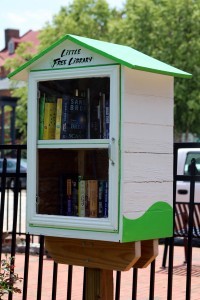
Free book promos aren’t for everyone. Some writers are passionate about receiving payment for their hard work. Other writers don’t yet have enough published work to offer one of their books for free. It’s possible, also, that writers of standalones might not find as much value in a free promotion as series writers.
For me, I’ve found that free book promos do have their place. I use them often. In fact, at least one of my books is always free.
I don’t like the idea of Kindle Unlimited (KU), because I don’t like putting all my eggs in one basket. I’ve also found that anytime I cut back on any platform, I hear from readers. And I hate making readers upset.
Instead, I use Amazon’s price-matching policy to make my books free. In the past I’ve used Smashwords (a book distributor) to make my book free on other retailers (Kobo, etc.) and then Amazon has rapidly matched the price. I’m now experimenting with Draft 2 Digital (another distributor), which I’ve really enjoyed dealing with so far. You can make your book free on Nook with Draft 2 Digital, which does put pressure on Amazon to match the price quickly. Also (and I’m straying slightly off-topic here, sorry), Draft 2 Digital seems much easier to work with. More on them on their FAQ page.
Ways I use free book promos:
To introduce readers to my books. They’re more likely to take a chance on a new-to-them author if the book is free. The free book functions as a sort of ‘loss leader,’ using grocery store parlance. The hope is that the promo funnels readers to my other books.
As an incentive for signing up for my newsletter. (I wrote about the mechanics of getting the free books into the hands of the readers in last Monday’s post).
To elicit reviews for a new book. Goodreads giveaways provide an easy way of doing this, if you’ve got a print edition of your book. But I’ve also found that reviews follow a free book promo on Amazon…usually several weeks after the promo has ended. It’s true that sometimes free books can result in lower ratings from readers. That’s because some of these readers aren’t our intended audience. But, for me, this strategy for gaining customer reviews has worked well, despite the occasional bad review.
To introduce my books to a younger demographic. Wattpad‘s users are mostly 30 and younger (with a heavy concentration of teenage readers). Since many of my readers are seniors, I’m trying to ensure a future for my series.
Do you use free book promotions? What other promo have you used successfully?
Image: MorgueFile: DodgertonSkillhause
Using free books as an incentive:
Click To Tweet
The post Using ‘Free’ as an Incentive appeared first on Elizabeth Spann Craig.
July 25, 2015
Twitterific Writing Links
by Elizabeth S. Craig, @elizabethscraig
Twitterific writing links are fed into the Writer’s Knowledge Base search engine (developed by writer and software engineer Mike Fleming) which has over 30,000 free articles on writing related topics. It’s the search engine for writers.
(developed by writer and software engineer Mike Fleming) which has over 30,000 free articles on writing related topics. It’s the search engine for writers.
For any curiosity seekers, I released my ‘cozy zombie’ book last week. :)
How to Polish Your WIP Before Sending: http://ow.ly/Q2lRG @ava_jae
Mini Writing Retreat: http://ow.ly/Q2lV1 @JulieMusil
No More Love Triangles, Please: http://ow.ly/Q2mxf @srsharms @bookriot
5 Things To Remember When Building A Blog Tour: http://ow.ly/Q2lH5 @MistyMassey
5 World-Building Tips for Writers of All Genres: http://ow.ly/Q2mga @SaraL_Writer
The Plotting Grid: a Tool for Plotters and Pantsers: http://ow.ly/Q4Wgl @ChrisMandeville @KoboWritingLife
Writing Selfishly: http://ow.ly/Q4WBr @kristaphillips
Casting the Thriller: http://ow.ly/Q4WDO by Shawn Coyne
Setting alerts for our name and books: http://ow.ly/Q4WFe @cathychall
10 Ideas for Descriptive Writing: http://ow.ly/Q4Wxu @WritingForward
4 Hidden Dangers of Writing Groups: http://ow.ly/Q4WyD @jennienash @JaneFriedman
What Secret Does Your Character Keep? http://ow.ly/Q2lZV @angelaackerman
How NOT to Publish a Picture Book: http://ow.ly/Q2lqi by Val Jones @2writingteachrs
Crime Writing: Determining Time of Death: http://ow.ly/Q2mpS @SueColetta1
A look at social class in crime fiction: http://ow.ly/PQ4U6 @mkinberg
When we’ve written ourselves into corners: http://ow.ly/Q2m4F @glencstrathy
3 Ways To Use Inverted Dialogue In Our Story: http://ow.ly/Q2mbm @AnthonyEhlers
Website Ranking: –5 Basic Metrics: http://ow.ly/Q2laD @karencv
Print Vs. Ebooks: Does It Pay To Do Print? http://ow.ly/Q2mlI @mollygreene
How To Write a Story 101: Character: http://ow.ly/Q0se0 @hodgeswriter
Writing Tighter Sentences: http://ow.ly/Q0rZ5 @lindasclare
How to use quizzes to promote a book: http://ow.ly/Q0rN4 @OramStephen
Audiobooks: Getting Started with ACX: http://ow.ly/Q0sxL @AmyPatrickBooks
Trad Authors, Do You Know Where Your Money Is? http://ow.ly/Q3pTH @angiehodapp
Why Podcasting Interviews Are Essential: http://ow.ly/Q0rHh @AudioMktgExpert @bookbaby
Increase Writing Productivity: 7 Tools: http://ow.ly/Q0sjr @nownovel
Estate Planning Basics for the Self-Published Writer: http://ow.ly/Q2gV4 @KathrynGoldman
Free Online Resources for Self-Publishers: http://ow.ly/Q0rTs @AuthorMelindaC
What to Include in Our Backmatter: http://ow.ly/Q0sRd @ceciliaedits
5 Reasons Smart Authors Love Instagram: http://ow.ly/Q0sHe @LauraMcNeillBks
Are book prices too low? http://ow.ly/Q1XAa Discussion at #FutureChat: 4pm BST, 11 am ET (now) @Porter_Anderson
The type of reader you write for may determine your writing process: http://ow.ly/Q1T4Y @BarryKnister
9 Ways to a Faster Book Deal: http://ow.ly/Q0s9L @susanshapironet
Why We Don’t Need to Worry About Protecting Our Idea: http://ow.ly/Q0s3a @BookEndsJessica
Authors’ Top 10 Misused Phrases: http://ow.ly/Q0sn5 by Annie Tucker Morgan
Create a Niche for Your Blog: http://ow.ly/PW6NH @RobertLeeBrewer
Political dissent in crime fiction: http://ow.ly/PQ4vy @mkinberg
The Brain on Storytelling: The Reader-Character Connection: http://ow.ly/PW6Zf @writerolody
Seating solutions for authors: http://ow.ly/PW79e @DebbieYoungBN
Why Your Novel’s Hero Should Fight a Good Guy (in 11 Uncontrived Steps): http://ow.ly/PW7cz @betternovelproj
Character Voice Consistency: http://ow.ly/PW6IJ @AmberSkyeF
5 Ways Writers Get Lazy: http://ow.ly/PW6fx @jodyhedlund
The joy of reading role-playing games: http://ow.ly/PW7zk @damiengwalter @guardianbooks
Want a great character? Find a loser. http://ow.ly/PW6Dg @CalebPirtle
Will Readers Find Our Protagonist Worthy? http://ow.ly/PW5yb @angelaackerman
11 Ways to Optimize Your LinkedIn Profile for More Exposure: http://ow.ly/PW6mv @kikolani
Author Epiphany: “I Film-Track My Novels”: http://ow.ly/PW64s @SarahMMcCoy”
Commonly Confused Words: – One Word or Two? http://ow.ly/PW5Wu by Melissa Gilbert
10 Costly Mistakes Authors Make: http://ow.ly/PTeQN @bookgal
4 Revision Goals: Conflict, Emotion, Surprise, Enrich: http://ow.ly/PTfGp @fictionnotes
Main Character Level: Expert! http://ow.ly/PTers @artofstoriesAB
What A Writer Learns from Facebook Partying: http://ow.ly/PTfta @angiedicken
Mistakes that 1st-Time Self-Published Authors Make: http://ow.ly/PTg6w @miralsattar @BiblioCrunch
11 Secrets to Writing Effective Character Description: http://ow.ly/PTcwQ by Rebecca McClanahan @writersdigest
How Expressive Writing Can Improve Our Emotional and Physical Health: http://ow.ly/PTfbC @paisleyhansen
Why Horror is Good For You (and Even Better for Your Kids): http://ow.ly/PTe2v and http://ow.ly/PTe7L @GregRuth
5 Fundamentals of Great Author Newsletters: http://ow.ly/PTbZn @cherylrwrites
Continuity Goofs: Avengers, Hunger Games and Our Novel: http://ow.ly/PTfQG @fictionnotes
Fishing Out Our Manuscript Hook: http://ow.ly/PTeGK @katemoretti1
Domestic Noir in Crime Fiction: http://ow.ly/PQ4f3 @mkinberg
How to Write Your Characters’ Thoughts: http://ow.ly/PTceh @cherylrwrites
Will We Ever Be Able To Trust Online Reviews? http://ow.ly/PSJKl @Porter_Anderson
Find Motivation To Complete Your Novel: http://ow.ly/PQaU3 @angee
Diversity in Our Characters: Economic Inclusion: http://ow.ly/PQeG1 @stacey_cochran @FionaQuinnBooks
Write between the soft edges of summertime: http://ow.ly/PV1E8 @JELindholm
Crutch Words: http://ow.ly/PQe07 @JessicaPMorrell
The importance of relationships in fiction: http://ow.ly/PQeeZ @shalvatzis
What authors think of Amazon’s Pay-Per-Page model: http://bit.ly/payperpage @ReedsyHQ @OrnaRoss @annerallen
6 Bad Reasons to Write a Novel …and 6 Good Ones: http://ow.ly/PQf6x @annerallen
Crime fiction where police have a presence but aren’t protagonists: http://ow.ly/PQ383 @mkinberg @kbowenwriter
Book Returns: What they Mean For Publishers and Authors: http://ow.ly/PSF4V @SpunkOnAStick
Tips for when we’re stuck when writing: http://ow.ly/PQfw3 @SarahLaddAuthor
On Time Transitions and Flow: http://ow.ly/PQaE7 from Black Crow Calling
During writing setbacks, remember it’s all about communication with a reader: http://ow.ly/PSEIH @megwolfewrites
The Authors Guild’s Stab at Reform and the Schism it Revealed: http://ow.ly/PSJnY @Porter_Anderson
Novelists that have woven together SF and crime fiction: http://ow.ly/PQ3OQ @mkinberg
30 Blog Post Ideas For Writers: http://ow.ly/PQeo4 @writers_write
Starting a Story: Don’t Mention the Weather: http://ow.ly/PQb2z
Embracing Discipline and Accountability: http://ow.ly/PQffV by Brian DeLeonard @mythicscribes
Supporting an author’s or illustrator’s new book: via @inkyelbows http://ow.ly/PQfMi
6 Methods to Build a Book Audience: http://ow.ly/PNOg7 @nownovel
12 Secrets to Selling More Books at Events: http://ow.ly/PNOtE @bookgal
4 Real-Life Starting Points for Story Ideas: http://ow.ly/PNOlZ @WanderfulWorld1
Good Screenwriting is About GREAT dialogue: http://ow.ly/PNODL @storiesin2light
Best Poems from the 21st Century Offer 3 Book Writing Lessons: http://ow.ly/PNO83 @nownovel
Emotional Wound Entry: a Role Model Who Disappoints: http://ow.ly/PNO5K @angelaackerman
The Brain on Storytelling: The Reader-Character Connection: http://ow.ly/PNOck @Writerology
How to Write a Short Story from Start to Finish: http://ow.ly/PNOhT @joebunting
What to do When Amazon Pulls Reviews: http://ow.ly/PNOni @bookgal
The Difference Between Genre and Category: http://ow.ly/PNOpH @brooke_warner
Make Book Trailers with YouTube’s Free Editor: http://ow.ly/PNOrq @RJCrayton
5 Ways the Hero’s Journey Affects Writing Process: http://ow.ly/PNOBi @ShannonGiglio
The Email Marketing Trap Fiction Writers Must Avoid: http://ow.ly/PMD3h @storyrally
Writing a Series – 6 Secrets: http://ow.ly/PMDri @nownovel
Is AutoCrit a Good Fit for Indie Authors? (Review): http://ow.ly/PMDyX @jenn_mattern
Tips for How To Show, Not Tell: http://ow.ly/PMDuk @SueColetta1
The ‘Bi-literate’ Brain: The Key to Reading in a Sea of Screens: http://ow.ly/PMDkK @manoushz @brainpicker
Publishing Contracts Matter To Indies Too: http://ow.ly/PMDNw @JaneSteen
Who Is Your Audience? http://ow.ly/PMDdc @McgannKellie
Top writing links from last week:
Click To Tweet
The post Twitterific Writing Links appeared first on Elizabeth Spann Craig.
July 23, 2015
Pantsers, Outliners, Savor Readers and Fuel Readers: Writer Beware
by Barry Knister, @BarryKnister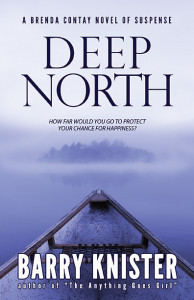
“Pantser” and “Outliner” are terms used by writers to describe different approaches to writing novels. The CEO of the very good website you’re visiting, Elizabeth Spann Craig has written effectively in personal terms on the subject.
In over-simplified terms, pantsers write as inspiration dictates, by the seat of their pants, whereas outliners do advance planning in the form of outlines before they begin writing their work.
Outliners are often both envied and pitied by pantsers. Outliners strike pantsers as drudges, people better suited to accounting or shredding documents. To a committed pantser, the very idea of outlining drains all the joy of discovery from the act of creation by approaching the job of writing as just that. A job, work.
At the same time, pantsers often experience bouts of wistful regret about not outlining. They don’t impose order and system on what they do, thus leaving themselves at the mercy of inspiration, alcohol, controlled and not-so-controlled substances, the muse, metabolism, and shifts in barometric pressure.
Outliners ignore all such crutches or empediments to “getting the work out.” Sick, bored, exhausted—no matter. They forge ahead like weary horsemen bent on reaching Dodge City by nightfall. The seat of the outliner’s own pants is glued to the chair in front of a computer. She or he bangs out each day’s chunk of carefully outlined material, then gets a little double-entry bookkeeping done before bed.
How about readers? Do they approach books in different ways? I think they do, and I would characterize the two polar-opposite styles of reader as Savor Readers and Fuel Readers.
The word “savor” is most often applied to food, wine, scenery, art. We speak of “savoring the moment” when a pleasurable experience draws from us a heightened level of attention and appreciation. In similar fashion, a savor reader gives her focused attention to what’s on the page, to be open to nuance and novelty.
Readers who—for whatever reason–have a special interest in language are more inclined to savor what they read, to delight in subtle observations, turns of phrase, insights into character, thought-provoking themes. They often favor stories that glorify the ordinary, that apply fresh lipstick to the commonplace.
On the other hand, the reader who fuels herself with fiction consumes novels voraciously. She usually wants Big Canvas characters and stories, with lots of movement in time and space, geo-political high stakes and, often, lots of technology, paranormal this-and-that, or galaxies far, far away. Bodice rippers, not frail young poets coughing into scented hankies are what supply her with literary nourishment.
The point of reading fiction for such readers is to be hustled along, transported through action and emotion. The idea is not for the book to make time slow down, but to make it fly, either before the next business appointment, or to escape the tedium of ho-hum domestic existence.
Just as with pantsers and outliners, there is no “good” or “bad” involved here, just the personal needs of readers. But for writers, these distinctions are worth keeping in mind.
The writer who doesn’t plan ahead and develop outlines for her books is almost certainly going to produce less work. That’s okay, provided the books she writes are targeted for savor readers who like to stop and smell the prose roses as they read.
But those writers who write for the darting eyes of fuel readers, for those who fan the pages and quickly move on to the next book, outlining is a necessity. Otherwise, the reader–looking up as the book she’s just tossed over her shoulder lands on the conical mound behind her chair–will not be a happy camper. She doesn’t read for subtle touches of wit or delicate shadings of emotion. She reads for escape, and she has no intention of waiting around while the writer dithers over details.
“Stop gazing out the window!” she shouts. “Get back to work!” Writers would do well to keep her in mind.
After a career of college teaching, Barry Knister returned to fiction writing. His first novel, a gritty thriller about Vietnam Vets titled The Dating Service had been published by Berkley.
Knister’s third novel, The Anything Goes Girl, is the first installment in the Brenda Contay Suspense series (Kindle ebook and CreateSpace paperback). Book Two in the series—Deep North— released July 21.
Barry invites readers to visit his website, BW Knister – Author of Just Bill and the Brenda Contay Mysteries Please use the site’s contact page to write directly to him. He would truly like to hear from you.
Outliners' and pantsers' books may resonate with very different types of readers (via @barryknister):
Click To Tweet
The post Pantsers, Outliners, Savor Readers and Fuel Readers: Writer Beware appeared first on Elizabeth Spann Craig.
July 19, 2015
Offering Free Ebooks to Subscribers
by Elizabeth S. Craig, @elizabethscraig
Warning: boring post ahead! But since I’ve struggled with Mail Chimp and Amazon, I thought I’d share what I’ve learned about both platforms.
Many writers offer free ebook incentives for signing up for their newsletter. I liked the idea of the giveaway, but I knew one thing: it had to be automated. I don’t have the time to email ebooks to readers in their preferred format.
After researching, I realized that I already had the tools to be able to get the delivery process automated…I just hadn’t realized it. Here’s what I did:
I use Mail Chimp for newsletters. It’s free for up to 2,000 subscribers. (Rest assured, if you’re on other newsletter platforms, no worries, you can use automation there, too…I just don’t know how. :) )
Pull up your newsletter campaign (https://us4.admin.mailchimp.com/lists/ ) . There’s a drop-down arrow next to “stats” and I selected “signup forms.” On the page that comes up, under “forms and response emails,” use the drop-down arrow and choose “forms”.
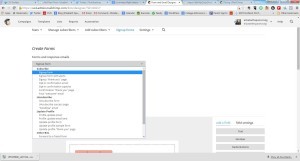
The forms that I used were “signup form,” “signup thank you page”, “opt-in confirmation email”, “confirmation thank you page” (but I changed it to “go to a link” instead of using the email on the Mail Chimp page…that’s a choice we can make on the form), and the “final welcome email”. We can upload images to any of these forms to make them more appealing for readers, if we use the image icon in an editable field.
I created images on the free Canva site. One was: “sign up for my free newsletter and get a free copy of Dyeing Shame.” I used that in the backs of some of my books. I hyperlinked the images in the “sign up” ad to my Mail Chimp newsletter signup page: http://eepurl.com/kCy5j . Then I downloaded the file as an image and then uploaded it to the Mail Chimp forms. Here are is the ad and the Mail Chimp forms:
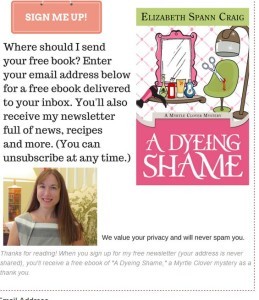
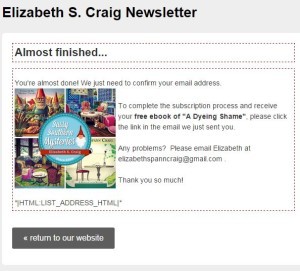



I created a page on my website with the links to deliver the free ebook. We can mark the page as public or private (page settings on WordPress). Instead of having Mail Chimp email the “Success!” notice with the download instructions, I set up the form to go to my site:
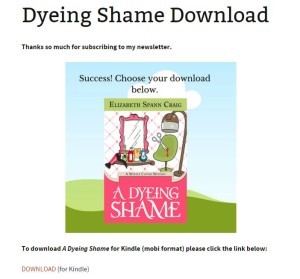
On the site, it has instructions and links for downloading the free book in Kindle, epub, and PDF formats.
For the download links, I used . I logged in with my Amazon login. Then I created a “bucket” called “dyeingshame” and uploaded 3 files: Kindle, epub, and PDF. When I selected each file on the site, a side menu came up. I chose ‘properties’, then ‘permissions’. Then I clicked the green arrow for ‘add more permissions.’ I then used the drop-down menu to select ‘everyone. and saved it. A minute later, the file was showing as public. I copied the file url and hyperlinked it to the ‘download’ text on my webpage.
I hope everyone’s still awake. :) This is a post that I’ll refer back to, myself, for future reference. I know it’s convoluted. But it’s not quite as difficult as it might seem.
This is one thing I’ve worked on recently, marketing-wise. What have you been working on lately?
How to offer and distribute free ebooks as incentives for readers:
Click To Tweet
The post Offering Free Ebooks to Subscribers appeared first on Elizabeth Spann Craig.
Twitterific Writing Links
by Elizabeth S. Craig, @elizabethscraig
Twitterific writing links are fed into the Writer’s Knowledge Base search engine (developed by writer and software engineer Mike Fleming) which has over 30,000 free articles on writing related topics. It’s the search engine for writers.
(developed by writer and software engineer Mike Fleming) which has over 30,000 free articles on writing related topics. It’s the search engine for writers.
When the Beginning Isn’t the Beginning: http://ow.ly/PMD7I @aejonesauthor
How to Create Shareworthy Twitter Images and Visuals: http://ow.ly/PMDoD @kevanlee
Tips On Writing And Productivity: http://ow.ly/PMDfG @thecreativepenn
10 Writing Productivity Hacks: http://ow.ly/PMDsD @nownovel
Create An Author Website That Shows Off Your Writer Personality: http://ow.ly/PMD9K @writersrelief
Who Is Your Audience? http://ow.ly/PMDdc @McgannKellie
9 Ways to Use Music to Enhance Our Writing: http://ow.ly/PJzv3 @WriterJoMalby
4 Questions Agents Ask Writers at Pitch Sessions: http://ow.ly/PJzT4 @FictionCity
Comma Splices and Why Editors Hate Them: http://ow.ly/PJzQ7 @epbure
Conflict: The Fuel Of Our Story: http://ow.ly/PJzIr @bob_mayer
Creative writing lessons from Patricia Highsmith: http://ow.ly/PJzLL @samjordison
How to Know When You’re Ready to Publish: http://ow.ly/PJA4x @bethrevis
5 Ways To Kick-Start Your New Short Story: http://ow.ly/PJzFd @AnthonyEhlers
Tips for building vocabulary: http://ow.ly/PJA1k from WriteWorld
10 Tips for Writing Unforgettable Villains: http://ow.ly/PJzr6 @cblinka
5 Minutes to Writing Better Guns and Knives: http://ow.ly/PJzAK @benjaminsobieck
Writing Spies: How to Find Bugs: http://ow.ly/PGncA @piperbayard
Cleaning Up Our Amazon Book Page: http://ow.ly/PJTmk
Learning From The Independent Publishing Experience: http://ow.ly/PGmQm @10minnovelist @JudeKnightBooks
The Hardest Part of Writing Good Character Arcs: http://ow.ly/PGmvu @KMWeiland
Traits and Character: http://ow.ly/PGm0k by Shawn Coyne
So Much Anger From Writers Online: http://ow.ly/PKozH @Porter_Anderson
On Exceptions to Writing Rules: http://ow.ly/PGn20 @ava_jae
Authors’ contracts and controversies: http://ow.ly/PJAxG @Porter_Anderson @janesteen
Discovering New Frontiers in Genre: http://ow.ly/PGnKd @artofstoriesAB
7 Tips For Writing About Trauma: http://ow.ly/PGmqZ @kelley_clink
Numbers in Writing: http://ow.ly/PGnjD @Savage_Woman
#FutureChat Today: The Amazon birthday party: http://ow.ly/PJAY2 at 4pBST / 11aET (now) : @Porter_Anderson
Writing Tighter Sentences: http://ow.ly/PGnLI @lindasclare
Confrontations between sleuths and criminals in crime fiction: http://ow.ly/PJNbi @mkinberg
Ambition, Writing Tips And Being An Indie At #ThrillerFest15: http://ow.ly/PGobm @thecreativepenn
Amazon, 20 years in: http://ow.ly/PJAQc @Porter_Anderson @philipdsjones
How ACX Earnings Work: http://ow.ly/PGnAj @amcbooks
How to Create Tension in Writing: http://ow.ly/PGlX9 @nownovel
6 Techniques for Retelling Classic Stories: http://ow.ly/PEE97 @artofstoriesAB
The Perfect Place to Write? A Field Guide to Procrastination: http://ow.ly/PEEij @cbramkamp
How to Describe a Place: http://ow.ly/PEFmL @JillWilliamson @goteenwriters
Tips for expanding our word count: http://ow.ly/PEEEa from Writing Questions Answered
20 Reasons Why Nonfiction Writers Should Blog Books: http://ow.ly/PEEeI @NinaAmir
How to Pace a Crime Novel: http://ow.ly/PEFwW @nownovel
Killing too many characters too early in the story? http://ow.ly/PEET6 from The Writing Cafe
Do A Character Study on Yourself: http://ow.ly/PEF64 @sowulwords @DIYMFA
The best way to plot a novel: http://ow.ly/PEFhC @StephMorrill @goteenwriters
Research Tips: http://ow.ly/PEEOe from Megan N. Moore
How to Create Your Own Mini Writing Retreat: http://ow.ly/PEFbv @DIYMFA
5 Tips for Setting Description: http://ow.ly/PEEnT by Rebekah Lee
Crippling Advice For Beginning Writers: http://ow.ly/PCxRk @jamesostafford
30 Ways Netflix Binge Watching Makes You A Better Writer: http://ow.ly/PCy34 @jimwoodswrites
5 Essential Marketing Ingredients To Make You A Better Writer: http://ow.ly/PCxSU @jimwoodswrites
How to Create a Convincing Good Guy: http://ow.ly/PCxPb @AJHumpage
3 Surprises You Need In A Story: http://ow.ly/PCyrR @MiaJouBotha
Creating Captivating Characters: http://ow.ly/PCz5M @Roz_Morris @VineLeavesLJ
5 Tips to Write a Great Main Character: http://ow.ly/PCyzU @artofstoriesAB
Naming your characters and settings: http://ow.ly/PCz56 @Roz_Morris
Tribute to the Self-absorbed Artist: http://ow.ly/PCzgG @mrJRPatterson @thePenleak
How to Write the Passage of Time: http://ow.ly/PCyIQ @AJHumpage
What to Expect from a First Draft: http://ow.ly/PCyvE @artofstoriesAB
Be Fearless: Make Your Characters Real: http://ow.ly/PCyUh @woodwardkaren
Writing Fixes: The Weak Opening: http://ow.ly/PCz0H @lindasclare
Why the best characters overshare (by @DrewChial ): http://ow.ly/PyOE2
4 Tips For Finding Beta Readers Right For You: http://ow.ly/PCyVD @woodwardkaren
5 guidelines for writing strong female characters (by @CWGWriting): http://ow.ly/PyOxR
5 dimensions of character personality (by @writingeekery): http://ow.ly/PyPc3
Tips from Hollywood for improving our writing (from Barking Up the Wrong Tree): http://ow.ly/PyNRC
Tips from writers on editing (from @JannaKaixer): http://ow.ly/PyNFi
A look at act structure through the lens of 4 character models (by @alrodz): http://ow.ly/PyO2d
Dialogue: Make it clear who’s talking (by @mariamurnane): http://ow.ly/PyOjO
Infographic on organizing a writing desk (from @DashBurst): http://ow.ly/PyPrK
Tips for short story writing and why to do it (by @MichelleRene00): http://ow.ly/PyOUA
Why query letters should focus on plot not theme ( by @carlywatters): http://ow.ly/PyNtE
Predictable elements in crime fiction (by @mkinberg): http://ow.ly/PwRV8
5 great story twists (by @AlexSokoloff for @bang2write): http://ow.ly/PyOLm
How to write a thrilling action hero (by Eric Owusu): http://ow.ly/PyNf6
Music for Writers: Composer @Laura_Karpman #MusicForWriters @Q2Music @Porter_Anderson ow.ly/PsuDn
10 Elementary Tips For Writers From Sherlock Holmes: http://ow.ly/PvyaW @writers_write
Staying True to Your Characters: http://ow.ly/PvxSF by Annette Lyon
Fiction Writing Basics: Character Thoughts And Emotions: http://ow.ly/PvxNc @angee
150 DIY ways to market your book: http://ow.ly/PvxDq @AuthorAshleeM
Applying Myers-Briggs to Characters: http://ow.ly/PvyhE @SaraCSnider
5 Ways to Handle Characters With Different Power Levels: http://ow.ly/Pvxvi @mythcreants by Oren Ashkenazi
The epic villain breakdown: http://ow.ly/PvxXo @shesnovel
Lessons From the Terrible Writing of Sword of Shannara (Ch.1) : http://ow.ly/PvxTz by Chris Winkle @mythcreants
10 Reasons Every Fiction Writer Should Learn Technical Writing: http://ow.ly/PvxKh @RMNSediting
7 ways to describe your protagonist in 1st person POV: http://ow.ly/PvxHa @kseniaanske
All about school visits (by @diannesalerni for @alexjcavanaugh ) : http://ow.ly/PwThK
10 short stories every writer should read: http://ow.ly/PvycM @johnny_webber
A look at fame in crime fiction (by @mkinberg): http://ow.ly/PwGNp
A Call to Pens: –Writer as Social Activist: http://ow.ly/Pvyld @jan_ohara
5 Tips for Guest-Blogging Like a Pro: http://ow.ly/PnNEM @write_tomorrow
Hit and Run Emotions: http://ow.ly/PnNcj @DiAnnMills
Do You Find Audiobooks Too Slow? http://ow.ly/PnMVA @InkBitsPixels
Writing and the Pomodoro Method: http://ow.ly/PnLji @rsmollisonread
Indie Authors: How to Get Visible in Libraries: http://ow.ly/Pvyt5 @Porter_Anderson for @annerallen
Tips for comma usage: http://ow.ly/PnK5A by Mary Norris @NewYorkerVideo
The post Twitterific Writing Links appeared first on Elizabeth Spann Craig.
July 16, 2015
Cleaning Up Our Amazon Book Page
by Elizabeth S. Craig, @elizabethscraig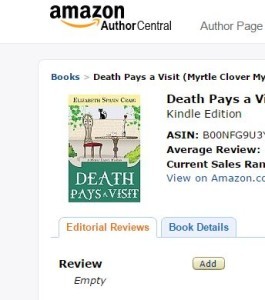
I mentioned in an earlier post that I’m taking author Mark Dawson’s Facebook ad course. It’s been incredibly helpful for a variety of different reasons. I’ve no affiliation with Mark—I’m just trying to figure out what the heck I’m doing on Facebook…a platform I dislike, but would like to be able to use to my advantage. The course is closed for registration now (he’s trying to keep it manageable so that he can directly assist enrolled students), but he does have a free mini course which I also took and found useful.
One of the things the course has done is force me do certain spring cleaning tasks that I should have been doing all along. Mark explains the concept of landing pages, for one. If we’re running an ad to increase subscriptions to our mailing list, the landing page would be a very basic page on our website that only allows the option of either closing the window or subscribing to the newsletter. An incentive for signing up, like a free book, would be included in the deal.
The landing page when running a Facebook ad for sales generation is our book’s sales page on Amazon. Mark recommended making sure that this page was in very good shape. The ad that I’m getting ready to run will promote a box set of mine (this is another recommendation from Mark.) So I had to look at the sales page as if I’d never seen it before and make sure it was ready for potential readers.
I found that it had a long way to go. Actually, I discovered that all of my book pages had a ways to go in terms of being attractive to potential readers. I also learned that, sadly, it took a lot of work to spruce them up.
I’ve gone through all of my self-published book pages at this point and made changes to the book/product description, the editorial reviews, and my own “about the author.” My Penguin book pages should also be touched up, so I’ll have to handle that next. I was surprised, as a matter of fact, to see that I could tidy them up. Since I hadn’t been the one to put them up on retail sites to begin with, it was nice to know that I could make changes to them.
Here is what I did:
Checked my “Look Inside.” Had I ever once looked inside my look inside? No. As I suspected, it was chockfull with copyright info, etc. Typical boring front matter stuff. Mark (and others I’ve read and tweeted on the subject) explains that this is valuable real estate and should be treated as such. I still went light on the ad copy stuff, although I did mention my newsletter and the incentive for signing up. I moved the front matter for the box set to the back of the book to make more room for a real sample read. I’ll do the same for the other books when I make time. We also want to make sure that this sample has no typos or formatting issues or anything else that will make readers want to stop reading.
I tweaked my book/product description through my KDP dashboard. Although I liked the descriptions I’d written, I decided that they weren’t particularly visually appealing. The box set, in particular, was sort of a mess. I used some very, very basic html code to make book titles in the set bold, etc. You can look here to see the results. Another thing I did was to use a little social proof. Since this is a box set and, as yet, an unreviewed box set, it made sense to add up the reviews for the books that comprised the set. Those three books had over 650 five-star reviews between them and it was dumb of me not to mention that.
So, on to social proof. My other books have plenty of reviews so I don’t list the social proof in the first line of the book description like I did for the unreviewed box set. I feel like readers can see the stars on their own, right at the top of the page. So I put the social proof down in the editorial reviews section. That’s the section that…get this…I was not using for any of my books. That’s right. I hadn’t gotten around to it, so it was completely empty. Just FYI, if you haven’t gotten around to it either, you access it through your Amazon Author Central…go to Books and then to Editorial Reviews, then click the add button. In the past, I’d simply let the reader reviews be the only reviews on the page. It’s true that I hadn’t made time to fill the section out, but it’s also true that I dislike marketing, dislike social proof. It seems like bragging and I was raised to be the modest Southern lady. It’s important to become someone different when we market.
So…say you have a series. You can add up the four and five star reviews for all the books in your series and make that the opening line of your book description. So I’ve got “Readers love Myrtle – over 1500 4 and 5 star reviews.” That’s it. That’s all we need. The code for that is: Amazon readers love this series – over 1500 4 and 5 star reviews If you want to check your code as you type it to see how it would look on Amazon, Mark Dawson shares a helpful site: http://ablurb.github.io/ . I found it very useful. It also has all the tags you can share listed on the site. I spent a good deal of time experimenting.
Next was my bio. It was…okay. I rewrote it to make it stronger.
Then I went through all of my self-published books and did the same thing.
It did take me a while. But I feel like the results were worth it. Moving forward, it’ll take a lot less time to handle this because I’ll do it as I’m publishing new books.
Have you been to your book’s sale page recently? How did it look? What are you working on now?
Tips for cleaning up our Amazon book page:
Click To Tweet
The post Cleaning Up Our Amazon Book Page appeared first on Elizabeth Spann Craig.
July 12, 2015
Writing a New Genre
by Elizabeth S. Craig, @elizabethscraig
After a really nice vacation to Alaska (where it wasn’t even close to the 100 degrees F we’ve had here in NC), I had a few things to deal with. A lot of unpacking, a suitcase that decided to hang out in Dallas, TX, instead of following us home, and a book to finish.
I’d hoped to finish the book during my vacation. I did get a lot written, but it wasn’t quite finished. I finally knocked out the last bit yesterday and then quickly cleaned it up to send it along to my freelance editor.
This book was an interesting project for me. It was an attack book…one that forced me to write it. It’s been bugging me for three years. I’ve got several other things to work on right now, but I scheduled time to work on this one.
I’d no idea how difficult it would be to write. I ran a couple of weeks over my self-imposed deadline. I’m happy with the finished product, but…it was a bear to write.
Why the book put me behind:
The zombies. I’ve never written zombies. I’ve had to read a lot of zombie stuff recently.
The fact that this was a gore-free zombie book with mild thrills. Not a lot of those out there.
The multiple POVs. I’ve never written multiple POVs. As I was writing them, I remembered scores of articles I’d shared on social media about challenges writers encounter with them. Now I know what those authors meant.
The first person POVs. I’ve never written in first person. It was awkward at first.
The epilogue. This book felt as if it needed one. I’ve never written/wanted one before.
What I learned while struggling through the project:
Although the book was difficult for me to write, I felt a lot of creative energy while writing it. This manuscript was good for me and helped me grow in areas I needed to work on.
Zombies are like many other conflict generators….it’s not about them. It’s about what happens to and within the characters, as with any other story.
For some reason, when writing multiple POVs, there is this tremendous urge that overwhelms one to recount the story we’ve just narrated from a different viewpoint. Resist! Rarely is this a good move. I knew this from a hundred articles I’ve read in the past…but somehow, when you’re writing, it seems like an amazing idea at the time.
When writing multiple POVs, timelines become an issue. I started tracking what day the different characters were on. When the characters’ timelines intersected, it was important to make sure one character wasn’t on day three and another character on day five. :)
Other things I was reminded of:
Crappy, unskilled work can be fixed during our edits.
It’s vital to schedule time to read the new genre.
It’s easy to get carried away with research. A timer is helpful.
If we feel like we’re blathering on and on, it’s best to start wrapping things up quickly.
Sometimes, it’s best to skip to the ending and write backward. This helped me out tremendously.
Challenges and lessons learned from writing a new genre:
Click To Tweet
Image: Death to the Stock Photo
The post Writing a New Genre appeared first on Elizabeth Spann Craig.
Twitterific Writing Links
by Elizabeth S. Craig, @elizabethscraig
Twitterific writing links are fed into the Writer’s Knowledge Base search engine (developed by writer and software engineer Mike Fleming) which has over 30,000 free articles on writing related topics. It’s the search engine for writers.
(developed by writer and software engineer Mike Fleming) which has over 30,000 free articles on writing related topics. It’s the search engine for writers.
Hope everyone has had a nice last couple of weeks. I’ve enjoyed a great vacation with my family and am now getting back into the swing of things again. :) This edition of Twitterific should include all the tweets I’d scheduled when I was gone. Hootsuite didn’t seem to want to cough up such a large number of links, but this is my manual reconstruction of what was scheduled. Thanks!
Auditioning a Narrator for your ACX Audiobook: http://ow.ly/PnMM2 @amcbooks
What It Was Really Like Writing Harry Potter: http://ow.ly/PnN1x from Write Like Rowling
Writing the Multi-Platform Novel: http://ow.ly/PnMDI @HDemetrios @ingridsundberg
Shawn Coyne on The Story Grid and Why Every Author Needs It: http://ow.ly/PnLro @LorenKleinman
The Flabby Midsection of Your Novel: http://ow.ly/PnLLc from The Authors’ Nook
All about liquid and gas explosions (resource for writers): http://ow.ly/PnOfK @johngilstrap @FionaQuinnBooks
Summarizing instead of showing action: http://ow.ly/Pj6w6 @ChristyDistler
Does Amazon Love Authors? http://ow.ly/Pj7BH @ornaross
Writing About Guns: 10 Errors to Avoid in Your Novel: http://ow.ly/Pj6Og @benjaminsobieck
Query Question: maps, illustrations and other visuals in novels: http://ow.ly/Pj6SB @Janet_Reid
All About Goodreads Giveaways: http://ow.ly/Pj7xF y @DebbieYoungBN
Top 90+ Free eBook Sites: http://ow.ly/Pj6FC @bkmkting
Ramp Up Tension and Pacing: http://ow.ly/Pj7td by Rachel Scott Thomson for @CSLakin
The Complete List of Creative Distractions and Defenses Against Them: http://ow.ly/Pj6Rg @DanBlank
Will author contract reform succeed this time? http://ow.ly/PtuAs @Porter_Anderson @philipdsjones
Writing Fix: Reinvent Your Story: http://ow.ly/Pj7mL @lindasclare
Email Newsletters for Authors: Get Started Guide: http://ow.ly/Pj6s4 @JaneFriedman
Q&A On Writing, Self Publishing And Book Marketing: http://ow.ly/Pj6Ld @thecreativepenn
How to Calculate Createspace Royalties: http://ow.ly/PhL9L @BlotsandPlots
Split Narratives: Dividing Your Story Between 2 or More Narrators: http://ow.ly/Pj6Ij @aliventures
Is Your Story Ending ‘Right’? http://ow.ly/PhJjj @HeatherJacksonW
When Should a Writer Start Building a Social Media Network? http://ow.ly/PhJTC @ediemelson
Public Shaming, Cyberbullies, and the Hive Mind: Fighting ‘Censorship by Troll': http://ow.ly/PhKnG @annerallen
The Poky Little Puppy and other awful canonical children’s books: http://ow.ly/PhKBu @gabrielroth @slate
5 actionable social media tips for writers: http://bit.ly/1HSVhXV @ReedsyHQ @RicardoFayet
Things to know about our characters: http://ow.ly/PhKtz by Right Writing
Making your book go viral: http://ow.ly/PhLlZ @rxena77
5 Step Recipe To Create Your Protagonist’s Inner Circle: http://ow.ly/PhJPr @sacha_black
10 Tips For the Beta Reading Stage: http://ow.ly/PhJDg @sacha_black
Is Crowdfunding the Way of an Author’s Future? http://ow.ly/PhKfJ @wherewriterswin
How to Self-Edit: Infographic: http://ow.ly/PhK9J @nownovel
How To Ignite Your Creativity, The Artist’s Way : http://ow.ly/PhK1U @carol_brill @womenwriters
What Book Jackets Teach About A Story’s Hook: http://ow.ly/PhJ2Q @HeatherJacksonW
Will Readers Find Your Protagonist Worthy? http://ow.ly/OIZgD @angelaackerman
‘A Year of Women’? How About ‘A Year of Publishing Parity’ Instead? http://ow.ly/PnNrP @LorraineDWilke @passivevoiceblg
How to Switch Gears and Increase Tension: http://ow.ly/OIZ4x from Read to Write Stories
Toning The Muffin-Top: The Flabby Midsection of Your Novel: http://ow.ly/OIZLR @BenSchmitt5
Pinterest for Authors: 6 Tips: http://ow.ly/OIZsF @LornaSixsmith
17 Things Learned About Writing From Structuring a Novel In 7 Days: http://ow.ly/OIZze @BenSchmitt5
10 Things a Writer Should Do Post-Conference: http://ow.ly/OIZbV @AlyciaMorales
Ebook Subscriptions Q & A: http://ow.ly/PnNiP @JAKonrath @passivevoiceblg
10 Lessons Learned While Writing a 1st Novel: http://ow.ly/OIZkq @EmilyWenstrom
5 Fiction Faux Pas: http://ow.ly/OIZ8G @AndreaMerrell
Why Authors Need Bookshops: http://ow.ly/OIZp4 @DebbieYoungBN
Choose the Right WordPress Theme for You: 10 Questions http://ow.ly/OIZiJ @JaneFriedman
What to expect from your book cover designer: http://ow.ly/PjdJg @idobookcovers @ReedsyHQ
How to Know When to Stop Editing and Move On: http://ow.ly/OIZes @missy_wilkinson
Novelists Need to Show AND Tell: http://ow.ly/OHzzv @cerebralgrump
How to Turn an Idea into a Plot: http://ow.ly/OHz4J @ava_jae
7 Writing Tips For Great Characterization: http://ow.ly/OI4vk @bang2write
Amazon’s Personal Connection: ” Review Policies Are Nothing New” http://ow.ly/PmfXg @victoriastrauss
What Makes the Best Story? http://ow.ly/OHzug @Janice_Hardy
How to choose the right viewpoint and narrator: http://ow.ly/PjdDc @KristenStieffel @ReedsyHQ
Revising Mundane Content: http://ow.ly/OHABY @Savage_Woman
Praising a publisher in a query: http://ow.ly/OHznD @Janet_Reid
3 Ways In Which Gardening Inspires Writing: http://ow.ly/OHzTO @rsmollisonread
Choosing a Genre: http://ow.ly/OHzZ3 @kristenlambtx
Is Online Life Real Life? Ask E.L. James. No, Ask @ChuckWendig : http://ow.ly/Pjbzz @Porter_Anderson
How to Use MailChimp to Grow Your Brand: http://ow.ly/OI3Uf @byReginaTV
How Self-Published Authors Can Distribute to Libraries: http://ow.ly/PiKJF @Porter_Anderson @JaneFriedman @libraryself_e
Editing in Layers: 7 Things to Search For In Your Manuscript: http://ow.ly/OI4a7 @stephmorrill @GoTeenWriters
73 Ways To Become A Better Writer: http://ow.ly/OI4sT by Mark Jaksch @writetodone
How to Secure a Traditional Book Deal By Self-Publishing: http://ow.ly/OHzey @JaneFriedman
Publishing: can subscriptions take the heat? http://ow.ly/PiKez @Porter_Anderson @HughHowey
Test That Scene: Is it Essential or Filler? http://ow.ly/OFW1m @HeatherJacksonW
How Expressive Writing Can Improve Our Emotional and Physical Health: http://ow.ly/OFWu4 @paisleyhansen @womenwriters
Author Websites: 5 Ways to Create Loyal Readers: http://ow.ly/Pjdzd @ReedsyHQ
Embracing Paradox as a Writer: http://ow.ly/OFWRH @kcraftwriter
The Back-up Antagonist: http://ow.ly/OFW4d @robinrwrites
The Rule of Three in Writing: http://ow.ly/PiLA2 @AnnieDaylon
An agent on challenges involved with self-publishing: http://ow.ly/PiJue @Porter_Anderson @jenazantian
On police jargon: http://ow.ly/OFWFH @LeeLofland
How to Distribute Non-ACX Audiobooks: http://ow.ly/OFWhy @amcbooks
How writers of endangered languages are embracing sci-fi – Ideas: http://ow.ly/OFW6K @brittkpeterson
5 Simple Ways to Take Your Manuscript from Unsolicited to Solicited: http://ow.ly/OFVY3 by Kyla Bagnall
6 Writing Techniques Learned at Storymasters: http://ow.ly/OFW9z @brunsdavid
5 Ways to Stretch Your Word Count: http://ow.ly/OFWBy @MCristianoWrite
5 Ways to Track Your Sales Without Amazon KDP’s Dashboard: http://ow.ly/OFWe4 @amcbooks
Top 10 Scrivener Features for Writers: http://ow.ly/OFWNG @Gwen_Hernandez
3 Steps to Problem-Solving in Storytelling: http://ow.ly/OD5UM @farrtom @whisperproject
Resolutions and Writing: Getting Back on Track: http://ow.ly/OD5Au @BethCato
6 Narrator Types: Infographic: http://ow.ly/OD65m @nownovel
Do You Write Like a Reader? http://ow.ly/OD5vp @gmori
Tips for Winning a Short Story Contest: http://ow.ly/OD5Hq @farrtom @whisperproject
Writing Crime Fiction: 7 Elements of Gripping Suspense: http://ow.ly/OD5Yi @nownovel
Breaking Bad Pilot Beat Sheet by Geoff Harris: http://ow.ly/OD4tk
Making An Incredible Character Arc Credible: http://ow.ly/OD59Y @ScreenplayHowTo by Steve Lam
Why Modern Technology Hates Suspense Writers: http://ow.ly/OD5pz @StuartRWest
Mo Willems on Writing for Children and Other Unembarrassed People: http://ow.ly/OD50g @jurgenwolff
The Poor Pessimist’s Guide to Not Writing: http://ow.ly/OD4AI @wordwhores @jeffekennedy
A site that helps keep up with book ranking: http://ow.ly/OD6IM @111publishing
Developmental question: conflicting feedback http://ow.ly/OCevw @Janet_Reid
Using Goodreads as an author: http://ow.ly/OCdW8 @HelenaFairfax
Generate Early Interest in Your Book by Asking Questions and Getting Feedback: http://ow.ly/OCcXL @booklaunchdemon
5 rules of writing romance: http://ow.ly/OCdoC @nicholesevern
Tips for getting our site ready for editors and agents: http://ow.ly/OCdcs @nicholesevern
How to Use Twitter, Facebook, and Pinterest to Build Your Platform: http://ow.ly/OCcDJ @booklaunchdemon
Where to Submit Short Stories: 25 Magazines and Online Publications: http://ow.ly/OCe6h @thewritelife
Want to Build an Email List? 7 Newsletter Platforms to Choose From: http://ow.ly/OCeqY @lisatella
Facebook Basics for Writers: http://ow.ly/OCd98 @EdieMelson
3 Ways to Save Money as a Writer: http://ow.ly/OCd2y @LoriHatcher2 @ediemelson
Our blogs should be as well written as our novels: http://ow.ly/OCeBO @CalebPirtle
How Indie Authors Pick Keywords: http://ow.ly/OCdME @kayelleallen
If Your Novel Needs More Urgency and Momentum, Ask These 7 Questions: http://ow.ly/OB8Hk @katrinschumann
Is Your Book a Young Adult Romance? Infographic: http://ow.ly/OB95i by Mollie B
So You Want to Write For, or Publish (or both) An Anthology? http://ow.ly/OB8Dl @CLSWINNEY @MorganStJames
How to Avoid a Sagging Middle: http://ow.ly/OB9nc @BetterScribe
How to write dialogue that’s convincing and full of life: http://ow.ly/OB93x @Roz_Morris
Plotting a Steampunk Scene: http://ow.ly/OB8Ta by Cogpunk Steamscribe
Writing And Finance: A Complex Juggling Act: http://ow.ly/OB90E by Eve Pearce
Mapping Character Change Using Psychological Theory: http://ow.ly/OB8Zn @grumpyrabbit
The phenomenon of celebrity fiction: http://ow.ly/OB9aO by John Vanderslice
6 Emotional Spices For Drama: http://ow.ly/OB8Q2 @JohnKrone_com
3 Secrets of Sentence Length Power: http://ow.ly/OB8RQ @JohnKrone_com
Revision Made Simple in 10 Steps: http://ow.ly/OB8Ll @nadinekenney @grubwriters
2 Keys to Creating Compelling Characters: http://ow.ly/OApSi @michaelschilf
Emotional Wounds Thesaurus: Suffering From A Learning Disability: http://ow.ly/OApTq @beccapuglisi
Adding Tension to Your Novel Writing: http://ow.ly/OApnB @writerslifeorg
5 title mistakes that kill Amazon sales: http://ow.ly/OApGe @karonthackston
The Index Card Method and Story Structure Grid: http://ow.ly/OApOT @AlexSokoloff
How 1 writer published 4 Books in 2 Years : http://ow.ly/OApLB @marymcnear @womenwriters
The importance of proofreading blog posts: http://ow.ly/OApwO @BloggingBistro
Bestselling Author? Prove It! http://ow.ly/OApJP @WhitneyDineen @womenwriters
Stay updated on publishing topics for writers at #FutureChat. 11am ET/4 pm BST (now). @Porter_Anderson
8 Reasons Why Good Books are Rejected by Agents: http://ow.ly/OApuC @robiniwrites
From Memories to Memoirs: Balancing Story and Reflection: http://ow.ly/OApDg @writingthrulife
Writing Fiction: Lessons Learned from Game of Thrones: http://ow.ly/OAptG @WritersLifeOrg
Dialogue in Memoir: http://ow.ly/OApzK @writingthrulife
3 Tips for Plotting with a Pantser: http://ow.ly/OzZ7zn by BK Vogt
Story: 4 Key Elements: http://ow.ly/OzZ42 @michaelschilf
What to Ask a Freelance Editor: http://ow.ly/OzYMx @Savage_Woman
Top 10 rural noir novels: http://ow.ly/OzYNS by Tom Bouman @guardianbooks
The Right Tool for the Job: Logline: http://ow.ly/OzYWM @ChrisMandeville
False Summits and How to Get to the Top Anyway: http://ow.ly/OzYQS @harryonthebrink
How Judgmental Are Your Characters? http://ow.ly/OzYTE @Janice_Hardy
On Getting Lost: http://ow.ly/OzYUo @danijshapiro
3 Tools to Make Great Images: http://ow.ly/OzYSH @Cara_Putman
3 Ways to Start Your Novel http://ow.ly/OzYLh @RuthanneReid
The dreaded competitive title analysis: http://ow.ly/OzYVm @j_finkelstein
4 Ways to Prepare for a Book Launch Even if You Aren’t Published Yet: http://ow.ly/OzYRT @Janice_Hardy
Email Marketing For Authors and Writers: http://bit.ly/1F6FeQo @JFBookman
6 Writing Techniques Learned at Storymasters: http://ow.ly/OwLbC @brunsdavid
9 Secrets to Selling More Books: http://bit.ly/1FR56pY @bookgal
The pitfall of false suspense: http://ow.ly/OwL5R @KMWeiland
How to Get Local Bookstores to Carry Our Books: http://bit.ly/1ApUbBr @nblackburn01
David Mitchell on How to Write: Neglect Everything Else” http://ow.ly/OwLwy @theatlantic”
3 Reasons to Take a Break From Our Writing: http://bit.ly/1F6DiXX @EmilyWenstrom
Editing Software Tools For Writers http://bit.ly/1GyPwy9 via @wvancamp
10 Tips for Choosing the Right Book Title in the E-Age: http://bit.ly/1ApPtnq @annerallen
Plotting to Save Writing Time: http://bit.ly/1Bm4rWt by Michelle Ule
How To Write A Killer Cover Letter to Publishers http://bit.ly/1Aq3hhK via @WritersEdit
What’s Your Book Marketing Plan? 6 Crucial Steps to Include – http://bit.ly/1F6Eqeh @MaggieLangrick
Can you reduce your book to 3 words and 3 lines? http://ow.ly/OuOIA @betsyashton
How do I Edit my Own Writing? 5 Steps: http://ow.ly/OuOgB @nownovel
Using Tricks From Other Writers: http://ow.ly/OuOwY @KAMcCleary
Why readers gravitate toward scenes over narrative: http://ow.ly/OuO3X @lindasclare
Outlining on Excel: http://ow.ly/OuOqS @KatZhang
Top 5 Challenges Faced by Writers: http://ow.ly/OuP8Y @TheProseApp
6 Ways to Use the New Facebook Video to Create More Engagement: http://ow.ly/OuOWo @bookgal
Keeping the Key Event and 1st Plot Point Straight: http://ow.ly/OuOzj @KMWeiland
Begin Your Novel with Action: A Good Rule? http://ow.ly/OuO1t @JeffGerke @JaneFriedman
Neil Gaiman On Making Good Art: http://ow.ly/OuOma @DonnaRadley
How to Sell Your Screenplay (for Absolute Beginners): http://ow.ly/OuP0l @JaneFriedman
5 Ways To Evaluate Your Feedback: http://ow.ly/OuOS7 @zoeyclark @bang2write
4 Steps That Can Keep Writers From Dismal Failure: http://ow.ly/Ossyk @jodyhedlund
Dry Eye and The Writer: http://ow.ly/Oss4I @doramachado
Writers hear the same question: What else you got? http://ow.ly/OsssI @CalebPirtle
The Zen of Organized Writing: 5 Steps to Take Today: http://ow.ly/Ost3x by Bryan Collins
4 Nonfiction Points of View: http://ow.ly/OssjL by Shawn Coyne
10 Meaningful Practices for Every Writer : http://ow.ly/OssBB by Melissa Clark
Music In Writing: Using Music To Layer Characters: http://ow.ly/OsrOV @MiaJouBotha
The Rule of Three: http://ow.ly/OssMh by Kim English
20 things learned from writing full-time for 3 years: http://ow.ly/OssXs @kseniaanske
A Writer Rethinks Her Morning Pages: http://ow.ly/Oss8M @msbookish
Adventures in Co-Writing: http://ow.ly/OsseT @jenmalonewrites
What Indie Authors Can Do about the Book Industry’s Discrimination Problem: http://ow.ly/OsrUZ @brooke_warner
Awards Profiteers: How Writers Can Recognize and Avoid Them: http://ow.ly/OnX0W @victoriastrauss
Radical revision: blow up and rebuild your novel: http://ow.ly/OnXHl @chrisrobley
Why Support Literary Writing? http://ow.ly/OnXaI @RohanQuine
What’s in a finished novel should represent a mere fraction of our ideas: http://ow.ly/OnY9A @NathanBransford
A Successful Book Launch Event: 5 Simple Steps: http://ow.ly/OnZU3 @MuseInks
Not All Hybrid Publishers Are Created Equal: http://ow.ly/OnYpr @JaneFriedman @PublishersWkly
The post Twitterific Writing Links appeared first on Elizabeth Spann Craig.
June 27, 2015
Twitterific Writing Links
by Elizabeth S. Craig, @elizabethscraig
Twitterific writing links are fed into the Writer’s Knowledge Base search engine (developed by writer and software engineer Mike Fleming) which has over 30,000 free articles on writing related topics. It’s the search engine for writers.
(developed by writer and software engineer Mike Fleming) which has over 30,000 free articles on writing related topics. It’s the search engine for writers.
I’m going to take a short summer blog break and will go dark until July 12th, when I’ll return with an extended Twitterific. :) Early wishes for a Happy Independence Day for my blog readers in the States.
The Pseudonyms of Icons (infographic): http://ow.ly/OaSGD @galleycat by Maryann Yin
Music For Writers: @vanderaanet ‘Hovering Flight’ http://ow.ly/OC8UZ @Porter_Anderson
Disembodied Dialogue: http://ow.ly/OgoGR @CaitSpivey
Tips to Tighten Our Scenes: http://ow.ly/OgoRX @patverducci
4 tips to turn you into an objective editor: http://ow.ly/OgoAO @standoutbooks
Can publishing use a little mindfulness? http://ow.ly/OC9co @rohan_21awake @Porter_Anderson
Break Your Story: Index Card Style: http://ow.ly/Ogp5U @patverducci
7 Mistakes to Avoid When Writing about the Military: http://ow.ly/OgoXb @brunsdavid and JR Olson
Naming a Memorable Character: http://ow.ly/OgoIl @tmtysinger
5 Common Questions About Being a Screenwriter: http://ow.ly/OgoEC @elbuder @indiewire
How 1 Author Embraced Story Structure Without Sacrificing Creativity: http://ow.ly/OgoPk @meredithresnick
Keep Your Main Character Visible: http://ow.ly/Ogp2W @CaitSpivey
The Pros and Cons of Self-Publishing: http://ow.ly/OEEwd @ceciliaedits
10 Tips for Creating Winning Characters: http://ow.ly/OgoME @skouguell @scriptmag
How to get good publicity out of bad book reviews: http://ow.ly/OgoCY @kotorcomics
Faked evidence in crime fiction: http://ow.ly/OCsqf @mkinberg
Show, Don’t Tell: What to Show and What to Tell: http://ow.ly/Ogp0g @lindasclare
Want to Write Well? Learn to Research: http://ow.ly/Oh4zf @byStevenRamirez
Is Self-Publishing Audiobooks A Sound Investment? http://ow.ly/Oh4Cm @roncallari
Writers’ Rituals and Why They Work: http://ow.ly/Oh4F3 @RobinStorey1
1 Writer’s Development Slate: http://ow.ly/Oh4Hs @rsmollisonread
The crazy life of writers: http://ow.ly/Oh4MZ @ellisshuman
How to Proofread on a Kindle: 5 Easy Steps: http://ow.ly/Oh4SE @CKmacleodwriter
Public Speaking Tips: http://ow.ly/Oh4Zq @laurashabott
4 Tips to Write a Better Character Portrait: http://ow.ly/Oh50H @monicamclark
4 Expert Tips for Self-Publishing Comic Books: http://ow.ly/Oh57O @trevoramueller @K8Tilton
How to build your writer’s platform: http://ow.ly/Oh5wg @GeoffHughes01
How Writers Can Get More From Facebook: http://ow.ly/Oh5EZ @WriteOnTrack_L
10 Ways to Find Your Ideal Audience on Twitter: http://ow.ly/Oh5Sr @EricaVerrillo
5 Steps for Researching Literary Agents: http://ow.ly/OEEy8 @ceciliaedits
Self-Publishing Scams: Keep the ‘Self’ in Self-Publishing: http://ow.ly/OiDiG @daveBricker
How Writing a Journal Prepared 1 Writer to Write a Novel: http://ow.ly/OiHPq @LauraNDiamond1
Gatekeepers for Indie Publishing: http://ow.ly/OiHtk @HughHowey
4 Steps to Developing a Solid Story Premise: http://ow.ly/OiBW4 @farrtom
Routines and Why We Can Stop Longing for “the” Creative Zap: http://ow.ly/OiBug @CreativeKatrina
The Audacity of Prose: http://ow.ly/OiIIY @ChigozieObioma
Business Musings: Whining: http://ow.ly/OiBE9 @kristinerusch
How to Tell if Your Idea for an eBook or Course Is a Profitable One : http://ow.ly/OiGyU @problogger
Authors: Should You Join A Box Set? http://ow.ly/OiHbV @tobywneal
Setting Up Amazon Author pages: http://ow.ly/OiHlX @tonyriches
5 Reasons Why It’s Great To Be A Writer Today: http://ow.ly/OiCL2 @DysLiteracy
How often do readers want our newsletters? Readers respond in the comments of this post: http://ow.ly/OkiH3 @WordWenches8
Invented language lessons from George RR Martin: http://ow.ly/OkhSR @alisonflood
SELF-e Gets Indie Books Into Library Catalogs: http://ow.ly/OEIUm @Porter_Anderson @libraryself_e
The Writer’s Formula to a Captivating Setting: http://ow.ly/Okhqc @joebunting
Stay updated on publishing topics for writers at #FutureChat. 11am ET/4 pm BST (now). @Porter_Anderson
How Art Can Heal Anxiety: http://ow.ly/OkhOM @McKellaSawyer
Naming chapters: pros and cons: http://ow.ly/OkhuE @glencstrathy
A Look At Points Of View: http://ow.ly/OkjEO by Aaron Miles for @fantasyfaction
Everyman: a character fit for the next 500 years: http://ow.ly/OkhyN by John Dugdale @guardianbooks
Delivering your message with a meme: http://ow.ly/OkjZY @jamesrcallan
When our plots seem vague: http://ow.ly/OkkSN @glencstrathy
Restarting a Stalled Plot with a Character Interview: http://ow.ly/OkhJW @JeanHenryMead
The 50 Best Apps and Resources For Writers: http://ow.ly/Oki1X @TheExpertEditor
SELF-e Gets Indie Books Into Library Catalogs: http://ow.ly/OEJ0b @Porter_Anderson @libraryself_e
Are Literary Journals in Trouble? http://ow.ly/OkjHp @JaneFriedman
Clear the Decks to Inspire Creativity: http://ow.ly/Om9Jq @DeeWhiteAuthor
Must-visit sci-fi websites for writers: http://ow.ly/Om9CL @nownovel
8 Compelling Themes for Dystopian Settings: http://ow.ly/Omb9Z by David Mesick @mythcreants
3 Literary Devices to Make Your Prose Sing: http://ow.ly/Om9NN @Janice_Hardy
Social Media Manners – 20 Basic Rules For Good Netiquette: http://ow.ly/Oma2t @writers_write
Blogging Mistakes Made by Authors: http://ow.ly/Om9A0 @EdieMelson
Don’t Muzzle (or Muffle) Your Writing Voice: http://ow.ly/Omaat @TomBentleyNow
Writing Powerful Scenes and Stories with Just 2 Characters: http://ow.ly/Oman7 @heatherburch
8 Steps to Discover Your Perfect Writing Process: http://ow.ly/Om9t3 @sacha_black
Character Development Worksheet: http://ow.ly/OmaHQ from Legit Writing Tips
On participating in a box set for charity: http://ow.ly/Om9S9 @Brenda_Novak
Why Authors Should Never Buy Amazon Reader Reviews: http://ow.ly/OmaxL @annerallen
The Doubt Monsters of Writing Book Two: http://ow.ly/OnXVi @s_lovett @DIYMFA
Crime Writers: The Language Of Police: Cop Slang: http://ow.ly/OnYL1 @LeeLofland
How to flesh out a character: http://ow.ly/OnYjq @nathanbransford
Powers of Three: On the Tricolonic Title: http://ow.ly/OnXmQ @IvanKreilkamp @The_Millions
How to Pitch a Literary Agent at a Conference: http://ow.ly/OnYDX @monicamclark
Developing Themes In Your Stories: The Premise: http://ow.ly/OnXMs @SaraL_Writer
4 Tips for Developing Your Voice: http://ow.ly/OEEpr @ceciliaedits
Crime fiction: making the scene resemble a suicide: http://ow.ly/OCsfQ @mkinberg
Writing a killer hook: http://ow.ly/OCcwp @SueColetta1
3 Reasons Why Your Writing Never Works Out The Way You Planned: http://ow.ly/OaUYk @rsmollisonread
Dialogue Tags: http://ow.ly/OaTfo @Jen_328
Virtual Reality For Writers: http://ow.ly/OaXvS @AboutThisLater @thecreativepenn
Mistakes 1 editor has seen: http://ow.ly/OaT51 @nicholesevern
Facebook vs. Amazon: Does a Buy” Button Make the Social-Media Site a Rival to the Retailer? http://ow.ly/OD7jy @themotleyfool”
Tips for Writing With Long Distance Partners: http://ow.ly/OC7aw @MorganStJames
14 Dos and Don’ts for Author-Bloggers: http://ow.ly/OaVDT @annerallen
Typing on a Dvorak Keyboard: http://ow.ly/OaVxi @SeptCFawkes
How to Import Your Novel Research Into Scrivener: http://ow.ly/OaVpb @shesnovel
Tips for Eliminating Crutch Words: http://ow.ly/OCrEd @JessicaPMorrell
How to Develop Realistic Characters: http://ow.ly/OaUyg by Suzanne Purkins
Good Agents Audit Royalty Statements: http://ow.ly/OaXd3 @AgentKristinNLA
Anatomy of a Best-Selling Story: Opposition: http://ow.ly/OaTnJ @kristenlambtx
4 Signs of an Unhealthy Agent-Author Relationship: http://ow.ly/O7iO0 @ChuckSambuchino
Build Your Platform With Flash Fiction: http://ow.ly/O7hPS @_AliciaAudrey
How to Find the Right Critique Group for You: http://ow.ly/O7h9z @InkedVoices
7 Lessons to Learn When Writing a Book: http://ow.ly/O7ilf @redslice
The 10 Rules of Write Club: http://ow.ly/O7hgZ @MetroMagNZ by Simon Wilson
The post Twitterific Writing Links appeared first on Elizabeth Spann Craig.

